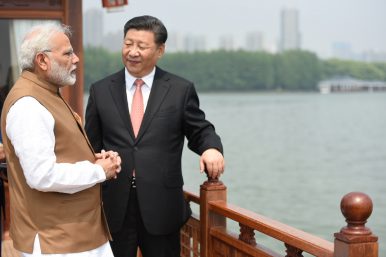By Ankit Panda
 Indian Prime Minister Narendra Modi and the right-wing Bharatiya Janata Party have won a powerful mandate in India’s 2019 general elections.
Indian Prime Minister Narendra Modi and the right-wing Bharatiya Janata Party have won a powerful mandate in India’s 2019 general elections.
As India forms a new government and Modi begins a second five-year term, one of the fundamental foreign policy challenges that will remain high on the agenda in New Delhi is the nature of the bilateral relationship with China.
Modi’s second term begins in a turbulent global context, with no sign that either the United States or China will unilaterally capitulate in the bilateral competition that exists between them.
During Modi’s first term from 2014-2019, India unambiguously recognised that its strategic interests in Asia would be best served by betting on the United States.
But beyond the great power rivalry context, Modi will carry forward a complex bilateral agenda with China into his second term.
The border dispute between the two countries remains as intractable as ever and concerns in Delhi about China’s big strategic and economic bet on Pakistan are growing.
In the days after India’s election results were announced, Chinese vice-president Wang Qishan conducted a rare visit to Pakistan, offering security assurances to ensure the integrity of Beijing’s multibillion-dollar investments in the China-Pakistan Economic Corridor, the crown jewel of the Belt and Road Initiative.
Meanwhile, one of the constant sources of anxiety during Modi’s first term came from the Indian region’s changing leadership temperament.
Countries like Sri Lanka and the Maldives recalibrated their relationships with China following changes in leadership that had little to do with Indian policy activism, while others, like Nepal, have moved toward a new normal, recognising that they no longer need to overwhelmingly rely on India.
India’s neighbourhood will no doubt remain a top priority in the second Modi term.
As difficult as the relationship with China remains, we can expect Modi’s second term to mostly yield continuity in New Delhi’s approach toward Beijing, which has in the past decade maintained a balance between cooperation – including economic cooperation – and strategic competition.
Even as India has long had concerns and misgivings about China’s rise – especially as Beijing’s presence becomes an undeniably reality around New Delhi’s strategic neighbourhood –, it has little to gain from taking a confrontational posture towards China.
While Modi has shown himself willing to assert India’s interests in the neighbourhood vis-à-vis China, his first term showed a continuing interest in expanding New Delhi’s stakes in sustaining a regional status quo favourable to India.
In particular, India expanded its naval and diplomatic engagement with like-minded diplomatic partners in the Indo-Pacific region – all while leaving the premise of balancing a rising China an implicit one.
The fundamental question that will underlie India’s policy planning for the relationship with China is whether Modi – and Indian prime ministers before him – had miscalculated the equilibrium point in the competition-cooperation dynamic with China.
Did India go too far to be accommodating and cooperating, emboldening China in its region?
A little over a year ago, Modi and Chinese President Xi Jinping held a carefully manicured bilateral show of reconciliation after a difficult year in 2017.
During a summit in the central Chinese city of Wuhan, which several analysts described as a “reset” moment, Modi and Xi sought to convey that the competitive-cooperative dynamic in India-China relations had regained its equilibrium after the summer 2017 stand-off between their armed forces over a once-obscure piece of disputed territory along India’s border with Bhutan.
An important moment to watch for later this year will be a second such informal summit between Modi and Xi. The Indian prime minister will host the Chinese leader for a second meeting later this year, according to Indian foreign ministry officials.
Absent a serious bilateral crisis in the intervening months, that meeting will allow for the two sides to set the terms of their engagement going forward.
There isn’t an easy answer to the set of challenges the new Indian government will face in the complex, multifaceted bilateral relationship with China.
But make no mistake: China will remain at the top of India’s foreign policy agenda for years to come.
This article first appeared in the South China Morning Post. It is republished here with kind permission.
No comments:
Post a Comment